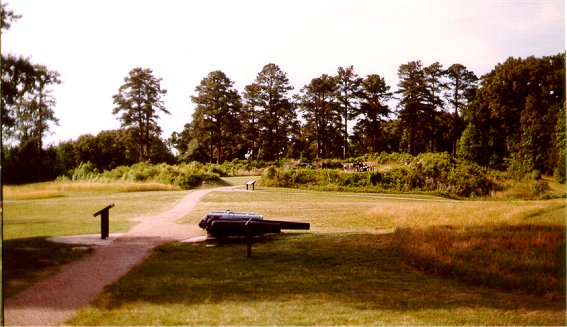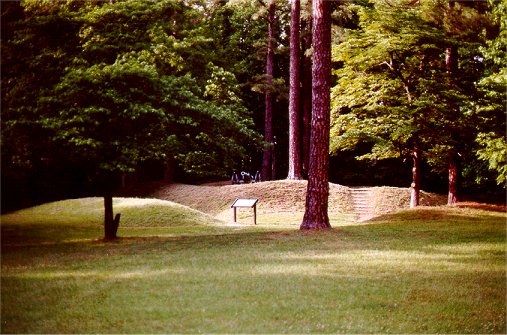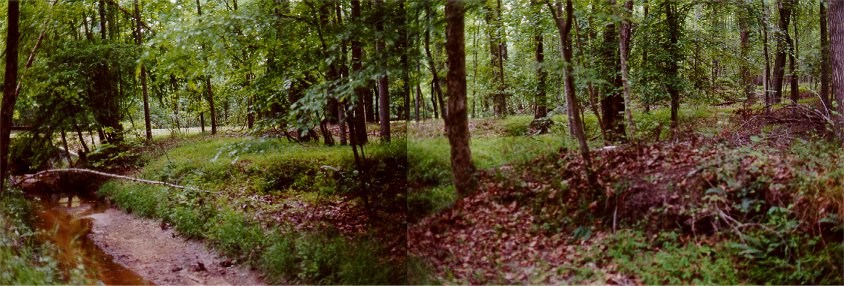
Petersburg Assaults
June 15 to 18, 1864
For the spring of 1864, Grant planned a coordinated attack on the Confederacy. In the West, Sherman successfully advanced on Atlanta. In Southwest Virginia, forces Crook and Averell raided the bridge over the New River in a campaign that climaxed at Cloyds Mountain. A Union force under Sigel advanced to defeat at New Market in the Shenandoah Valley. The Army of the Potomac advanced with the intention of destroying Lee's army.
The Army of the James composed of the X and XVIII Corps under Benjamin Butler aimed to take Richmond. Butler, with assistance from the Navy, transported his army from Fortress Monroe up the James River. A detachment was landed at City Point to threaten Petersburg while the main army landed at Bermuda Hundred, the area between Richmond on the James River and Petersburg on the Appomattox River. The Confederates, under Beauregard, managed to assemble enough troops to hold off Butler, who withdrew behind entrenchments on the Bermuda Hundred peninsula.
Meanwhile Grant had slowly advanced south having battled Lee at the Wilderness, Spotsylvania, and North Anna. Grant ordered William French Smith's XVIII Corps to join him north of the James for his efforts at Cold Harbor. His attacks having failed, Grant planned to cross the James and take Petersburg, which would make Richmond and the whole state of Virginia untenable. Sheridan and his cavalry were sent west to meet Hunter's Raid at Charlottesville. Confederate cavalry prevented this junction at the Battle of Trevalian Station and Early's II Corps moved west to stop Hunter.
On June 9, 1864, 1,800 infantry and 4,500 cavalry had crossed the Appomattox from Bermuda Hundred and attacked Petersburg. A small Confederate force fought them off, but Grant's big move was now the works. On June 12th, Grant abandoned his entrenchments and marched toward the James, where engineers were building an amazing 2,100 foot long pontoon bridge, the longest of its type ever made. Smith's XVIII Corps moved by transport back to Bermuda Hundred. There, they then crossed the Appomattox and advanced on Petersburg.

Battery 5
Early in the morning of June15th, Smith and his XVIII Corps crossed the Appomattox and advanced on Petersburg. A fight at Baylor's Farm briefly delayed them, but the Federals reached the Dimmock Line protecting Petersburg at 11AM. Smith inspected the Confederate lines until 3 PM and then personally explained his attack plan to each division commander. Then at 5PM, problems developed with the artillery. Finally, at 7PM, the attack began. Because the Confederate works were weakly held, the Yankees advanced entirely as a skirmish line. This saved many Union lives and proved quite successful. This is a view from the rear of Battery 5 of the Dimmock Line. Men of the 13th New Hampshire advanced uphill and over the ditch on the right of the picture. Confederates surrendered to the small band of New Englanders as black troops moved on them from behind. These men, from the 1st United States Colored Troops (or USCT), had advanced up an unprotected ravine and had broken through the Rebel line further south.

Battery 8
The Confederate line was rapidly disintegrating. Men from the 1st, 22nd, and 4th USCT moved south along the Confederate line. Among the positions taken was Battery 9. The battery was on a slight hill and commanded the positions already taken. Two companies of the 1st USCT cleared obstacles from around the battery, alowing the regiment to charge. The Confederates fled with little resistance. By 9PM, the Yankees had taken Batteries 3 through 11, in all over three miles of the Confederate line. Despite having a clear path into Petersburg, Smith declined a night advance, believing that Rebel reinforcements were on the way. The Army of the Potomac was on its way.

Harrison's Creek
Confederate reinforcements did arrive that night, and a new line was formed along Harrison's Creek. With the arrival of Hancock's II Corps, which should have been present on the 15th, Union forces amounted to 30,000 on the morning of the 16th against just 14,000 Confederates. By the time of the 6PM Union attacks along Harrison's Creek, the Federals had 50,000 men to just 14,000 Rebels. Much of this area was farmland at the time, and Confederates had a clear field of fire from atop the small hill on the right of the picture. Hancock attacked with little sucess and suffered over 2,000 losses.
At dawn the next day, June 17th, Burnside's newly arrived IX Corps attacked along Harrison's Creek. The attack was successful, with Potter's division pushing the defenders back, but the incompetent division commander Ledlie failed to exploit the gains. At 2PM, an attack by Willcox's division failed. That evening, Ledlie attacked, breaking the Confederate line, but Confederate counterattacks and darkness saved Petersburg. The battle would continue another day.